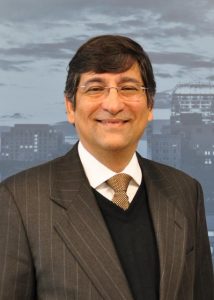Note: This is the first in a series of profiles of leaders in today’s utility analytics marketplace.
“My job is to make people uncomfortable with the way they do things today. Transformation implies a revolution, not small incremental changes, and today the big revolution in any industry is in data," said Francisco Itriago, Director, Transformation Solutions, Commercial Team at AES. "Digital data has changed everything and has created an exponential opportunity to expand learning, accelerate insights, monetize them and serve society. Analytics helps organizations seize the value and insights from data, in real time, to adapt and thrive in a fast-changing and competitive environment."

And with that we were off and running! It was a pleasure to sit down recently and chat with Francisco, who's a bit of a unicorn in our industry. Whereas the utility space is typically characterized as being risk averse, Francisco is looking to push, pull, cajole and otherwise lead the industry into this new era where data will be as important as electrons.
How did he get here?
A native of Venezuela, Francisco has a BS in Animal Science from NC State University and an MBA from the University of North Carolina. He originally planned to help run the family ranching operations in Venezuela, but ended up following an unusual career path that led to diverse roles in marketing for Heinz, followed by stints in banking, energy and at HBO. But there was a common theme in all of these roles: Learning and transformation. Francisco's specialty was taking established business processes and equipping them for changing market conditions -- the perfect background for today's utilities industry.
After his role at HBO, Francisco returned to Venezuela to run the family ranches, only to have a different type of revolution -- the socialist type -- confiscate his family's ranches. Still interested in energy, data and transformation Francisco made his way to AES.
Today’s challenges and opportunities
Francisco sees his role as being an influencer and transformation agent at AES. He sees a lot of confusion, both in general and in the utility industry, about the meaning and potential of “analytics.” Francisco sees analytics as a “must-have” for any energy company to be successful in the years ahead.
When asked what he sees as driving analytics in the utility space, Francisco said, “All energy is going to be distributed and mobile eventually; the existing grid will become a grid of microgrids of both energy and digital information. This ‘cellular grid’ will require different layers of complexity to manage a vast amount of coordination and intelligence across the enterprise. These microgrids might become more reliable than the existing grid itself. Large commercial and industrial (C&I) customers, representing a concentrated segment of the customer base and seeking more control to protect the high value of their products and market share, will drive the need for high-performing microgrids and ultimately shape the market, since they need a reliable and intelligent electric supply to run their businesses.”
Francisco continued “The C&I grid of microgrids will be like a live and evolving biological system, requiring an advanced nervous system capable of automated unconscious responses, as well as a ‘smart brain’ to extract knowledge, learn and make conscious decisions from a huge amount of data embedded in the energy and the work done with it. Analytics will be at the core of this central nervous system and its brain.”
Utility and energy companies will need to forge intimate partnerships with proven software and technology companies for this to all work, Francisco said. "None of them can win alone; speed of change matters in the race to survive. The winners will be the ones who transform and reach exponential levels of collaboration and results the fastest.
Moving ahead
At AES, Francisco sees strong senior executive support for this evolving business model. The organization is on an agile learning curve as they move into analytics. “We’re taking decisive steps in the right direction," he said.
In the broader industry, Francisco sees the value of analytics in both the modernization and automation of existing business functions. For instance, in energy commercialization and forecasting (which often still includes a largely manual and Excel-driven process), as well as applying analytics in new areas – like smart electric transportation networks or in live-targeted offering of new products and services to customers. He envisions electricity and analytics as vital hidden components and small costs in high-value-added products.
Looking further ahead, Francisco sees challenges that the industry is struggling to tackle. These issues include a lot of missed opportunities (electric vehicles, new customer offerings, high-value products that went to communications and technology companies because they embraced digital changes before utilities started to pay attention), the potential for massive amounts of stranded assets, bankruptcies, continued consolidation, as well as new and unexpected market entrants (note: We're seeing some of this already starting to happen).
But, even with these challenges, Francisco points out that utilities were once a major transformation agent and he is optimistic about the utility industry’s unique mission and century+ record of delivering electricity and value that has literally changed how we live. He concluded: “Utilities that embrace transformation again, and combine data and analytics with their electrons at the core of their operating model will get or stay ahead of the competition and have a place in the future energy landscape.”
If you'd like to learn more about transformation in the utility industry, download this white paper: Analytics and the Modern Energy Supplier.
